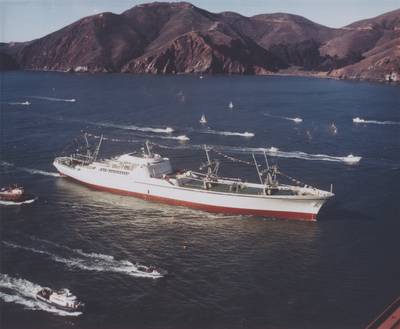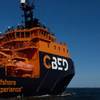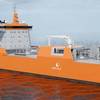The Nuclear Option
In the eyes of some, the March 2011 Fukushima Daiichi nuclear disaster was the event that would signal the end of nuclear power for electrical power generation and would end any hope of the world utilizing nuclear-powered commercial vessels other than the Russian barge carrier, SEVMORPUT and numerous Russian ice breakers. Contrary to the afore mentioned opinion, I believe that not only are selected-route nuclear powered commercial vessels good for the marine industry but they also offer the world the most environmentally friendly and potentially the most economical and efficient way of shipping trans-ocean cargo.
Although the Fukushima Daiichi disaster was a disaster of major proportions, we must not forget that it was initiated by a much more deadly and destructive disaster; a tsunami caused by a magnitude 9.0 Richter scale underwater earthquake. The nuclear disaster that occurred at the Fukushima Daiichi complex was not caused by inherent problems with the reactor, but rather by a series of compounding non-nuclear casualties that resulted in major damage to the reactor core and/or spent fuel storage facility at one or more of the six nuclear power plants in the complex. Essentially the nuclear casualty was the result of the loss of coolant to the plants and the resulting overheating of active and spent fuel rods. Tsunami-induced damage resulted in the total loss of offsite and emergency Diesel power, with the eventual loss of battery-backup DC power. Without electrical power, all engineered safeguards necessary to maintain coolant flow through the core were eliminated, causing subsequent overheating of the core and fuel melting.
One must remember that a shipboard nuclear power plant is, in essence, floating in an almost infinite source of coolant, and in all but harbor operations, the vessel containing the reactor would not be significantly affected by a tsunami and thus would always have the principal cooling source available. The one exception to this is if the nuclear powered vessel were picked up and thrown ashore, as seen in the video footage of the tsunami hitting the Tohoku region of Japan.
Another fact that must be noted is that the Fukushima Daiichi reactors were all generation II reactors and were not designed for passive cooling of the core as a means of preventing overheating if all electrical power is lost. New reactors are generation III units and are significantly safer than the units involved in the Fukushima Daiichi disaster. Rather than relying on engineered safeguards requiring electrical power, these designs make use of existing temperature gradients in the shutdown reactor to drive natural circulation of the coolant. Combining the use of generation III reactors with the almost unlimited source of cooling water make a coolant based casualty such as the one at Fukushima Daiichi essentially impossible if specific fail-safe requirements are factored into the design of a vessel with a generation III reactor.
From an environmental perspective, nuclear powered commercial vessels are the cleanest mode of transporting cargo. They release no carbon dioxide, no carbon monoxide, no methane slip, no sulfur oxides, no nitrogen oxides, no particulate matter and their potential for spilling oil is essentially zero since the only propulsion plant oils carried aboard are lubricating oil and oil for standby and emergency diesels.
An argument can be made that the nuclear spent fuel is a major pollutant. My response to that is yes it is if we elect to let it be, but if we are rational about the issue of spent fuel this form of pollution can be minimized. If we reprocessed the spent fuel using the best available technology existing today, not only would we greatly minimize the amount of radioactive material that has to be stored long-term, but we would reduce the amount of virgin fuel needed for the reactors — less mining of uranium ore and initial fuel processing. The technology is available; all that is needed is political leadership and a sound national nuclear waste management policy. This is not only a maritime issue, but an issue impacting the entire nuclear utility industry. If nuclear powered commercial vessels were used, the overall contribution to the nuclear waste problem would be miniscule since the number of nuclear powered commercial vessels would most likely be limited and they would have much low power levels compared to electrical utility power plants.
Another potential source of pollution created by nuclear powered commercial vessels is if the vessels were lost at sea. The sinking of such a vessel and the eventual release of radioactive materials from a damaged or corroded reactor vessel could potentially lead to a release of radioactive material into the oceans. This represents a potential risk, but it should not be a show-stopper for using commercial nuclear vessels. With appropriate design and planning it should possible to maximize the protection of the reactor and the radioactive parts of the plant, and to plan for “release and retrieval” of these components if required. If a nuclear powered vessel foundered and the reactor were on the ocean floor, the segments of the marine industry that have developed the expertise in deepwater salvage would, as in the past, be called upon to accomplishing the near impossible. I am reasonably confident that if the reactor or appropriately designed containment vessel had to be retrieved from the ocean floor, the marine salvage industry would successfully respond. Indeed, the containment vessel could be designed with this scenario in-mind, and be fitted with special disconnect and rigging connections to facilitate removal and retrieval.
Power requirements for ships are relatively low as compared to modern state of the art nuclear power electrical generating plants. To place this in perspective, a modern 1.3 to 1.5 GW, pressurized water reactor plant requires approximately 100,000 hp to drive the feed pump. Fortunately, there are those in the utility industry that appreciate the advantages of distributed power and the need for smaller modular nuclear plants. A number of national and international companies are designing reactors of sizes that could be used to power commercial vessels. At present there are six commercial reactor designs as well as one design by the U.S. Department of Energy in various stages of review by the U.S. Nuclear Regulatory Commission. They range in power from 10 MW(electrical) to 311 MW(electrical) . The designs extend from light water cooled pressurized water reactors to liquid metal cooled (two sodium cooled and one lead-bismuth eutectic) to gas cooled (helium).
Although designed for electric power generation, it is not too extreme to extrapolate the designs to make one or more of these modular reactors suitable for shipboard use. It seems to me that a manufacturer of one of these mini-sized reactors would be delighted at the potential to expand the market beyond the electric utility industry and sell essentially “off-the-shelf” reactors to the commercial marine industry.
Considering the relatively recent advances in shipboard electrical systems including distributed power and the use of propulsion pods it seems a natural extension to generate the shipboard electrical power using nuclear power instead of internal combustion engines or gas turbine prime-movers. The availability of nuclear power plants in the range of 100+ MW opens up the possibility of high speed marine transportation unaffected by the cost or availability of fuel oil or concern about emitting global warming gases. Imagine the economics of a fleet of mega containerships operating at 35 kts vs. 25 kts crossing the Pacific, Atlantic or the Arctic Oceans.
Although there are advantages of having nuclear powered commercial vessels, there are also many issues and potential liabilities that must be addressed. These issues range from port entry protocols to security (including hijacking) to nuclear waste disposal to nuclear accident indemnification. The indemnification issue is the same issue that shore-side nuclear power plants initially faced in the 1950’s. The issue was addressed at the time and resulted in the 1957 Price-Anderson Nuclear Industries Indemnity Act was last renewed in 2005 for an additional 20 year period. This Act partially indemnifies the non-military nuclear industry against liability claims from nuclear incidents while ensuring compensation coverage for the general public. It is interesting to note that Price-Anderson Act provided the NS Savannah with the liability coverage to allow the vessel to be accepted into many of the world’s ports.
In the following paragraphs I will outline a suggested approach for achieving the goal of having a high- speed fossil fuel independent commercial marine ocean transportation system.
To simplify the achievement of a high speed fossil fuel independent commercial marine ocean transportation system, the number of ports on both ends of the ocean crossing receiving the nuclear powered vessels should be limited to two, possibly three. At the ports visited by the nuclear powered vessels, the cargo would be loaded onto feeder ships or land transportation systems.
Ideally the trans-ocean element of the system would be accomplished by a consortium of companies and would represent the individual countries where the terminal ports are located.
An appropriate, multi-national consortium as well as using limited ports for the nuclear powered vessels should simplify the process of establishing the appropriate protocols for having nuclear powered vessels arriving and departing the ports of call. Vessel flagging and manning would be decided on by the consortium and be representative of the nationalities of the companies making up the consortium. Design, construction, classing and operating standards would be essentially the same for all vessels operated by the consortium. The role of countries hosting the ports of call of the nuclear powered vessels would be to demonstrate leadership by encouraging commercial entities to invest in the project and facilitate the necessary protocols and assist the local municipalities to prepare for the operation of the high speed fossil fuel independent commercial marine ocean transportation system. The countries forming the consortium should also share in the indemnification of the vessels in owned and operated by the consortium.
The advantage of having the high speed fossil fuel independent commercial marine ocean transportation system owned and operated by a specific multi-national consortium is that the impacted countries would all have “skin-in-the-game” and it would be in the best interest of the involved counties to fully cooperate. This cooperation would not only impact on the economics of the system, but should lead to strong cooperation to insure the safety of the vessels and the crews and strong cooperation in the prevention of terrorist and/or pirate attacks, including hijacking.
The Fukushima Daiichi Nuclear Disaster should not be viewed as the death-nail of nuclear reactor powered commercial vessels, but rather after understanding the facts of the tragedy and the needs of the 21st Century; it should be seen as the catalyst for establishing a 21st Century, pollution clean, fast and efficient ocean transportation system.
“Once Upon A Nuclear Ship”
New film chronicles the life, death and resurrection of historic ship
Once Upon A Nuclear Ship, a new documentary by filmmaker Thomas Michael Conner, tells the story of the NS Savannah the world’s only nuclear powered merchant ship that was once the diamond in the crown of the U.S. merchant fleet.
Imagined by President Dwight D. Eisenhower in 1955 and built by the New York Shipbuilding Corp. in Camden NJ from 1957 to 1962, the Savannah sailed the oceans of the world for 9 years before being taken out of service in 1971. In her brief lifetime she visited 77 ports of call hosting 1.5 million visitors and proved that a nuclear powered merchant ship carrying cargo and passengers was a viable option to smokestacks spewing soot and other contaminants into the air and laid the groundwork for a future that never came to be.
It’s a story best told by the men who “were there when it happened” and although many of these pioneering seamen have sailed into the sunset, Conner tracked down some key players and let them tell the story in their own words. It’s a story he too knows well because he was a member of the health physics (radiation protection) staff and was there from the day the reactor split it’s first atom then sailed on the ship until the end of 1964. The NS Savannah was the only merchant ship requiring a special department for the assessment of radiological hazards.
Once Upon A Nuclear Ship follows the Savannah through all of her trials and tribulations from the keel laying to her decommissioning and abandonment to her resurrection in 2006.
Today, the NS Savannah sits beside a dock in Baltimore MD while a small group of passionate people led by Erhard Kohler and Jon Stouky of the US Maritime Administration are busy preserving the history and technological know how that produced the Savannah in the first place. Stouky like Conner was involved with the Savannah since the New York Ship days in Camden and is currently the project’s Nuclear Advisor. Future plans include using the ship as a Maritime Museum.
Once Upon A Nuclear Ship is being released on DVD through TCL Communications, Inc and is available on it’s own website http://nssavannahdocumentary.com. Future plans include making it available via download or streaming.
To order your copy Once Upon A Nuclear Ship,
Contact: Tom Conner
Tel: 517-546-9230
http://nssavannahdocumentary.com
Email: [email protected]
(As published in the September 2012 edition of Maritime Reporter - www.marinelink.com)











